#HowtoAnswerAssignmentQuestion
Text
How Can You Use The Harvard Referencing Style?

Introduction
When you are new to undergraduate studies, referencing may not seem like something important. Although the assignment requirements at levels three and four may not emphasise the importance, it actually is. The assignments at these levels give you many good opportunities to learn how to reference the sources that you use. Take advantage of these opportunities. When you get to level five where referencing is a core requirement, you will already be good at it. That’s a smart thing to do!
Within business and management studies, the Harvard referencing style is commonly used. This is the same for many other fields. How can you use the Harvard referencing style though? This article will teach you how to use the Harvard referencing style. You will also learn about the resources that you can use for Harvard and other referencing styles. What does academic referencing mean for starters?
What is Academic Referencing?
Academic referencing is the act of acknowledging the sources of information that you use in your academic work such as essays, reports, and dissertations. This draws the reader’s attention to where you got the information, ideas, or quotations from. It allows the reader to consult the source if they wish to know more about the topic. Or, in the case of a lecturer, to verify the authenticity. In business and management studies, you have to acknowledge the author of each source that you use twice. That is, by in-text citation and referencing.
Academic referencing vs In-text citation
Both concepts are similar and are used interchangeably. However, they are not the same. The differences are below:

In-text Citation
In the Harvard referencing style and many other styles, an in-text citation is the first time an author is acknowledged. This is when the author is cited where the information was used in your work. For example, if you wrote an author’s idea in your own words within the first paragraph, you cite the author in that paragraph. The in-text citation gives only brief information about the source such as the surname and year of publication. When you quote an author word-for-word, include the page number in the in-text citation. The in-text citation can either be integrated into the sentence or not integrated.
Below are examples of in-text citations for Harvard referencing style in different scenarios. These are general examples. Ensure that you check the version of Harvard referencing that your college or university uses. It would mostly be the same, but it is worth checking.
Integrated into the sentenceNot integrated into the sentenceOne author: Brown (2019) states that it is important to study our history for a better understanding of current issues.
According to Brown (2019), it is important to study our history for a better understanding of current issues. One author: These current issues will make more sense if we study our history (Brown, 2019).Quotation: Brown (2019, p.44) “states that it is important to study our history for a better understanding of current issues.”Quotation: “These current issues will make more sense if we study our history” (Brown, 2019, p.44).Two authors (the same book or article): Brown and Smith (2019) state that it is important to study our history for a better understanding of current issues.
According to Brown and Smith (2019), it is important to study our history for a better understanding of current issues. Two authors (the same book or article): The current issues will make more sense if we study our history (Brown and Smith, 2019).Three or more authors (the same book or article): Brown et al (2019) state that it is important to study our history for a better understanding of current issues.
According to Brown et al. (2019), it is important to study our history for a better understanding of current issues.
Note: Some versions of Harvard referencing include et al (which means ‘and others’) when there are four or more authors, not three or more.Three or more authors (the same book or article): The current issues will make more sense if we study our history (Brown et al., 2019).More than one author (different books or articles) but the same idea: Jones (2020) and Johnson (2022) agree that it is important to study our history for a better understanding of current issues.More than one author (different books or articles) but the same idea: It is agreed that the current issues will make more sense if we study our history (Johnson 2022; Jones 2020).One author (two books or articles) in the same year, same idea: Brown (2019a) and Brown (2019b) state that it is important to study our history for a better understanding of current issues.One author (two books or articles) in the same year, same idea: The current issues will make more sense if we study our history (Brown, 2019a; Brown 2019b).
Referencing
Unlike in-text citations, academic referencing includes all the important details when acknowledging a source. These are the author’s name(s), date of publication, title of publication and place of publication. In addition to the surname included in the in-text citation, the initials of the other names are added. The references for all the sources cited in the work are listed alphabetically at the end. The important information in a reference can be categorised under four headings. These are who, when, what and where. Below are examples using the Harvard referencing style.



Who (Name of the author or organisation if there's no name)When (date of publication)What (name of the book, journal, and title of the article)Where (place of publication, name of publisher, volume, and page numbers)
Book Reference Structure: Surname, Initials. (Year). Book title, (include the edition here if there is one). Place of publication: Publisher.Brown, J.(2018).The History of Modern Science.Cambridge, Cambridge University Press,
Academic Journal Reference Structure: Surname, Initial. (Year). ‘Title of article’. Name of Journal. Volume (Issue), page numbers.Jones, A.(2020).‘The Effects of Exercise on Mental Health.’ Journal of Health Psychology,25(3), pp. 123-135
Website ReferenceStructure: Surname, initial. (Year). Page Title. Available at: URL: (Accessed: Day/Month/Year)Brown, C.(2019).The Benefits of Meditation for Stress Reduction.Available at: https://www.mindful.org/the-benefits-of-meditation-for-stress-reduction/ (Accessed, 15/04/2023
These are examples of the general structure used for the Harvard referencing style. Your institution may have slight variations based on the version used. If there are, you will find them in the referencing style guide or instructions.
Why is Academic Referencing Important?
Academic referencing is important in several ways. Below are some of the popular ones:
Credit Where Credit is Due
Citing and referencing the source used in an academic work gives the deserved credit to the author. This is a good academic practice that recognises the contribution of others to the field. It is also another way to show the academic integrity of the student.
Research and knowledge
The citation and references in your work show the depth and breadth of research that you have done. This shows the extent of your knowledge and understanding of the topic. Also, it adds credibility to the perspectives in your work and positively contributes to the grade.
Prevent Plagiarism
Using someone else’s ideas or information and not acknowledging them amounts to plagiarism. This is a serious academic offence. Citation and referencing are safe ways to avoid this.
Further Research
The references in your work allow others to find the sources to learn more if need be. Also, your lecturer can use references to verify the information in your work.

Popular Referencing Styles
Besides the Harvard referencing style, there are many other referencing styles. The referencing styles that you have to use will depend on your field of study, country of study and your institution. Ensure that you check to be sure you are using the required one. Below is a list of some of the commonly used referencing styles:
- APA (American Psychological Association) referencing style.
- MLA (Modern Language Association) referencing style.
- MHRA (Modern Humanities Research Association) referencing style.
- Chicago/Turabian referencing style.
- Vancouver referencing style.
- IEEE (Institute of Electrical and Electronics Engineers) referencing style.
- AMA (American Medical Association) referencing style.
- Oxford referencing style.
- OSCOLA (Citation of Legal Authorities) referencing style.
- AGPS (Australian Government Publishing Service) referencing style.
- AAA (American Anthropological Association) referencing style.
- AGLC (Australian Guide to Legal Citation) referencing style.
Referencing Tools and Resources
You don’t necessarily have to write the references of the sources you use from scratch anymore. There are many tools and resources for referencing these days. However, you need to know the right structure or format for different types of sources. This is because some of the online tools and resources may return references with minor errors.
Also, the references they produce may not be exactly what your institution requires. In both cases, you can easily correct them if you know the right structure or format. To get the reference of a source you are using via an online library or database, find the link called ‘cite’ or quotation marks. See an example below from Google Scholar, circled in red:

When clicked, it opens five different referencing styles for the source:

Below are several referencing tools and resources that can be used for different referencing styles in many ways. This includes providing referencing guidance, generating references, and managing your references. The goal is to choose a suitable one that you are comfortable with and familiarise yourself with. There are also YouTube videos on how to use most of them.
Cite Me RightMendeleyJabRefCitation MachineCiteFastRefWorksCite This For MeRefMeEndNoteCitaviEasyBibBibMeZoteroPapersZetoroBib
Conclusion
Academic referencing is a very important part of your academic written work. This is because it contributes to the credibility and accuracy of your work. It helps you avoid plagiarism and impacts your grades positively when done right. The further you go in your studies the more important it becomes. Ordinarily, a level five (second year of undergraduate) piece of academic work that includes all the right information and answers the question without citations and references may not pass.
However, if all the sources used are cited with a list of references, it will pass with a good grade. So, it is worth investing time in knowing how to cite and reference in your field of study. Learn how to find the sources to use in your assignment here.
Read the full article
#HowCanYouUseTheHarvardReferencingStyle?#HowtoAnswerAssignmentQuestion#Howtodoassignment#PopularReferencingStyles#ReferencingToolsandResources#Whatisacademicreferencing?#WhyisAcademicReferencingImportant?
0 notes
Text
Can I Use ChatGPT to do My Assignment?

Introduction
A burning question among students is “can I use ChatGPT to do my assignment?”. The answer depends on the intention behind the question. Is the intention to use ChatGPT to actually produce the assignment? Or the intention is to use ChatGPT for support while doing the assignment?
ChatGPT, like other artificial intelligence (AI) tools, can be a force for good in education. Sadly, like many good things, they can be used wrongly. The issue is not ChatGPT but how it is used. This article will cover how ChatGPT and other AI tools can be used acceptably for assignments. Also, unacceptable usage of these AI tools for assignment is looked at.
What is ChatGPT?
ChatGPT is a large language AI model developed by OpenAI. The AI is created to generate human-like responses to natural language queries using different language-based tasks. Some of these tasks are translation, conversation, and summarising. ChatGPT uses texts available on the internet to create an appropriate response to a wide range of queries. There are three versions: GPT-3, GPT-3.5, and GPT-4.
Acceptable Ways to Use ChatGPT for Assignment
There are some generally acceptable ways in which you can use AI tools for your assignment. The same goes for ChatGPT.
Research Aid: You can use AI tools to search for relevant sources and information to back the perspectives and arguments in your assignment. This is a good way to find information quickly and efficiently. The sources you find are then used and cited in your assignment. Learn how to effectively use sources in your assignment here.
Proofreading: AI tools can be very helpful when it comes to editing or proofreading your assignment. They identify errors that are easy to miss and make suggestions for improvements. The overall quality of your assignment can be enhanced this way.

Grammar Support: You can use AI tools to check the grammar and spelling of your assignment. An example is Grammarly. Using these tools can help you improve the quality of your writing with fewer errors. Check more ways that ChatGPT can be used in this Harvard Business School article.
Other Usage: Besides these generally acceptable usages, there may be more specific usage that your lecturer, course or university allows. Ensure to find out. For example, using ChatGPT to generate general ideas that research is then done on may be one. Another may be to assess critical thinking by having students analyse and compare content produced by AI with that of a human.
Unacceptable Ways to Use ChatGPT for Assignment
There are some clearly unacceptable ways when it comes to using AI tools or ChatGPT for assignments.

Deception: The use of AI or ChatGPT to create the impression that an assignment was originally created by a student when it wasn’t is deceptive. In this case, the assignment may have been created by other means. This can lead to serious consequences, some of which are mentioned above.
Terms and Conditions: Some AI tools, including ChatGPT, come with terms and conditions that prohibit using them for assignments and exams. They do not allow usages that violate academic integrity policies. There are legal consequences when they are used in ways that violate their terms and conditions.
Plagiarism: It is not allowed to use AI or ChatGPT to generate your entire assignment or parts of it. Doing this amount to plagiarism which violates the academic integrity policies of most institutions. This will result in serious consequences such as failing the assignment, the course, or even expulsion from the university. However, in an unusual situation when an assignment requires that you produce work using AI, maybe to test your AI proficiency, the instructor will make this clear. In this case, there should be proper citations to avoid plagiarism.
Conclusion
Although ChatGPT and other AI tools can be helpful when doing your assignment, they should only be used to enhance your assignment in acceptable ways. They cannot be used to replace your own ideas, views, perspectives and writing. Where you use them, ensure to check with your lecturer or student services office to be sure following the rules. Finally, it is best practice to use ChatGPT and other AI tools responsibly and ethically. Learn how the sources you find via AI tools can be used like a lecturer in your assignment.
Drop your questions (and thoughts) in the comment box below.
Read the full article
#AItodoassignment#ArtificialIntelligenceforassignment#CanIUseChatGPTtodoMyAssignment?#ChatGPTforassessment#HowtoAnswerAssignmentQuestion#Howtodoassignment
0 notes
Text
How do You Start Your Assignment? Follow These Tried-and-Tested Steps to Start like a Pro!

Introduction
Have you ever read through an assignment question and asked yourself how do I start answering this? You are not alone. Students sometimes find it challenging to start working on an assignment due to several reasons. Whatever the reasons are, a good approach is to develop a strategy that works and stick to it for every assignment.
With time, this becomes second nature to you. In this article, I will share a tried and tested approach that will help you start every assignment like a pro. If you think about it, the best way to start an assignment and be sure you are going in the right direction is to start from the question! This is exactly what we are going to do using the question below.

Identify the Key Words
The keywords are normally topic-area words and limiting words. Learn more about the topic area and limiting words here. In the assignment question above, these are the underlined words. We need to start from here to know what to look for when searching for materials to read for the assignment.
A common misconception that students have is that the more knowledge you have the easier it is to answer assignment questions. Although knowledge helps, this is far from the truth. Instead, the better you are at researching and finding the right materials the easier it is to answer assignment questions.
The good news is that research skills are learnt, we are not born with them. Think about it this way, if one learner searched and read two sources on a topic, say internet marketing, and another learner searched and read ten sources on the same topic who do you think would know more?
As a university student, your knowledge doesn’t matter as much as the extent and standard of your research skills. The earlier you start learning how to research the better you become as you progress academically. These steps help develop initial research skills.
Determine Where to Search for Materials
Once the keywords have been identified, the next step is to find the topic-area words in the recommended books and other sources for the module. You will normally have access to these, if not, ask the tutor or lecturer. Access can be via an online library or via a brick-and-mortar library. This post focuses on online access only.
At level four (first year of undergraduate studies), you may find a good amount of information about the topic area in the recommended books and other sources to write most of your assignment. This is not the case for level five and beyond. If you are a level four learner, it is a good idea to start learning how to find sources online because that is the definite destination you are going to.
So, the earlier you start, the better in the long run. Your university/college online library would normally be linked to websites, databases and platforms where you can search for sources. Some examples of these are sciencedirect.com, bibliu.com, jstor.org, ebsco.com, eric.ed.gov, scopus.com, springer.com.
A broadly similar approach is used to search for sources on these online resources. Beyond what your university offers, scholar.google.com offers access to millions of academic sources. Put simply, as a student, Google Scholar is your friend. Use it. Let’s have a go
Link your University Library to Google Scholar
To avoid having to access all the different academic websites, databases or platforms that your university already subscribes to, link your university to Google Scholar. This will allow you to access all the available sources around your topic area in one go on Google Scholar. Follow the steps below to do this. Let’s link Arden University Library.
Open scholar.google.com and click the menu icon on the top left corner.

Click on Settings in the menu and go to Library Links
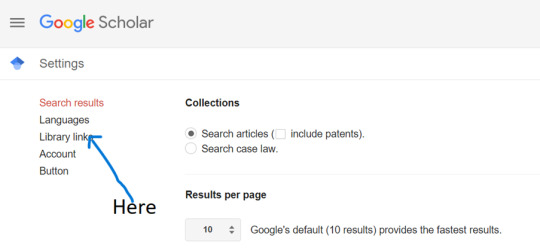
Type the name of your university in the search bar and click search. Your university will come up as it did for Arden University. Tick the box and save it below.
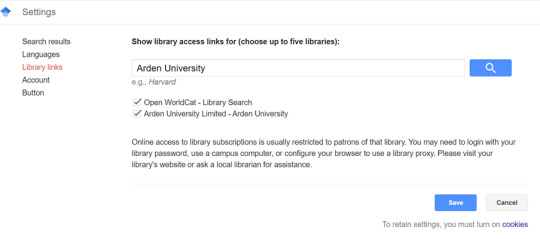
Ensure that you sign into your university library on the same browser before using Google Scholar. The materials that your university has subscribed to will appear as Pdf or other files on the right-hand side of the results. For example, before linking Arden University Library, besides the free materials which are available to everyone, the paid ones were not accessible below:
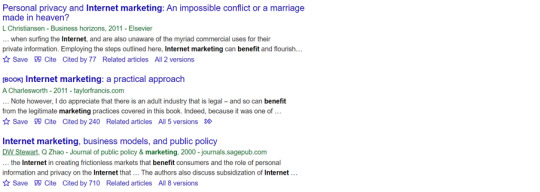
After linking, the ones that Arden University subscribes to become accessible as seen below:
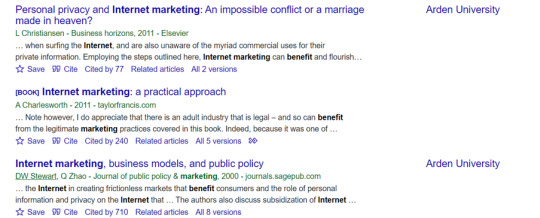
Use the Keywords to Search for Materials
To get materials that you can start reading to answer your assignment questions, you can use a combination of the topic words and limiting words. For example, by using 'internet marketing benefits' the following materials come up:
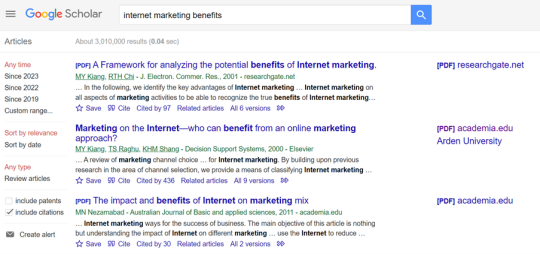
Other combinations can be ‘internet marketing opportunities’ ‘internet marketing challenges’ ‘internet marketing principles'. Sometimes, because of the topic area, it may be challenging to find sources using these combinations. Or, you may have to sift through too many sources to find suitable ones. To avoid these issues, Boolean Operators can be used. See examples of Boolean Operators provided by the University of Oxford here.
Conclusion
A problem that students struggle with is how to find the right materials to do their assignments. Following these steps helps you solve this problem. The strength of these steps is in using them consistently and how well you adapt them to your individual style. Like every good thing, it takes practice to perfect these steps in a way that suits you.
Having the materials to use for your assignment is a major step towards doing it properly. However, using the right materials such as journal articles and book chapters positively contributes to your grades. These steps will help you get the right materials. Learn how to use the materials you find here.
Drop your questions (and thoughts) in the comment box below.
Read the full article
#HowdoYouStartYourAssignment#HowtoAnswerAssignmentQuestion#Howtodoassignment#WhatshouldIdoinMyAssignment
0 notes
Text
What Am I Required To Do In My Assignment? Consider The University Requirements

introduction
Knowing the requirements for assignments and exams at your level of study helps you prepare better before any assessment. You can make the best of the time spent on lessons, workshops, tutorials, studying and general discussions with lecturers and peers. That is, you can get involved in discussions, and activities and ask questions that will help you better meet the requirements at your level of study.
Sadly, some students go through universities without ever knowing what these requirements are. Had they known, they would have prepared for assessments a lot better. Also, their grades and final classifications would have been better consequently. Luckily, this won’t happen to you, because you are here to learn! What are those requirements though?
Bloom’s Taxonomies of Learning
Bloom’s Taxonomies of learning is generally used in many universities to classify the different outcomes expected of learners at different levels. To learn more, check out Harvard University’s article on Bloom’s Taxonomies here.
This article will clarify how the different parts of Bloom’s Taxonomies apply to assessments at the different levels of undergraduate studies. The information here will help you better prepare and write your assignments and exams at each level. The breakdown below is based on a typical three-year undergraduate degree.
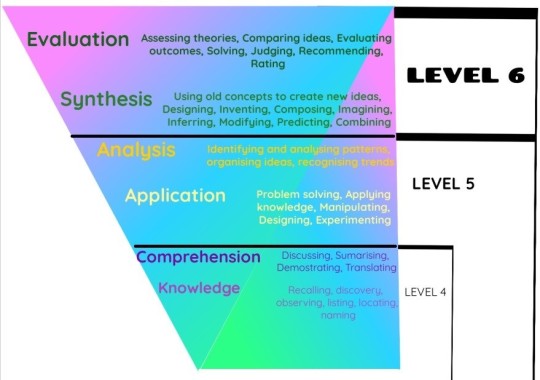
Bloom's Taxonomies of Learning
What is required at Level Four (Undergraduate Year 1)?
At level four your assignment should clearly show good understanding. To show good understanding in your assessment, you have to first comprehend the meaning of the theories, concepts and perspectives within the topic areas involved. Understanding can be shown in discussions and summaries of what these are.
Also, good learners at this level should be able to discover and locate the materials written by the sources or authors of the required concepts, theories and perspectives. Some basic research skills are required for this. If these are not learnt at level four, it normally impacts performance at level five.
Considering that there is a big jump from level four to level five in terms of academic requirements and the extent of studies, it is always better to have learnt these skills by the end of level four. However, some learners learn them at level five and still go on to graduate with great degree classifications.
What is required at Level Five (Undergraduate Year 2)?
The skills and abilities developed at level four are built on at level five. That is understanding from comprehending the meaning of concepts, theories and perspectives and the basic research skills. Applying concepts and theories to practice or phenomena can’t be done properly without a good understanding.
At this level, the knowledge gained can be manipulated or adapted for effective application. But the main emphasis at level five is analysis. Learn how to analyse practically here. Analysing theories, concepts and perspectives, as well as their application, allows learners to show critical and lateral thinking. These are core requirements for level five assessments.
At level five, you have to consciously avoid descriptive writing, which would have been used to show understanding at level four. Unlike at level four where textbooks were more ideal, you are expected to start using journal articles at this level. This contributes to your grades which start counting towards your final classification. Also, it prepares you for the standard of research required at level six.
What is required at Level Six (Undergraduate Final Year)?
The skills developed at levels four and five are built on at level six. That is the clarity in your writing that comes from good understanding and critical analysis skills. Synthesis can be developed from an analysis. This is by combining the varying perspectives around concepts or theories in the analysis to create new ideas.
Similarly, evaluation can be developed on analysis. Learn how to practically develop your analysis into evaluation here. At this level, the perspectives and positions in your work must be informed by the literature, especially academic ones. Also, the judgements and claims you make must be supported mostly by the literature, and facts in some cases.
Where literature is not used to inform your work, the grade would be very poor. Although this starts at level five, there should be solid evidence of independent studies beyond what is covered in the module. You can show this by using suitable theories, concepts, sources and literature that are beyond those covered in the module.
Conclusion
We have all heard that knowledge is power. However, when knowledge is not used or applied, we can’t derive power from it. But when knowledge is used properly, it can give us significant power in various situations. In this case, doing your assignments and exams. Wisdom is having knowledge, experience and good judgement. The best judgement to make from the experience and knowledge acquired here is to develop a study strategy accordingly.
This strategy can be adapted as you progress in your studies. You already have the knowledge. You know what’s required of you. Be wise and develop a strategy to stick with. This will help you smash those exams and assignments like a boss! Learn How to Answer Assignment Questions Like a Lecturer here.
Drop your questions (and thoughts) in the comment box below.
Read the full article
#HowtoAnswerAssignmentQuestion#Howtodoassignment#UniversityAssignmentRequirements#WhatamIrequiredtodoinmyassignment?#WhatshouldIdoinMyAssignment
0 notes
Text
What Should I Do In My Assignment? Think Like a Lecturer: Dissect the Command Words!

Introduction
Would you rather think like the lecturer that set your assignment question while answering it, instead of going by your own interpretation? How can you think like the lecturer when you don’t have the superpower to read minds? Actually, you can read the part of the lecturer’s mind that matters for your answer. The clues are all in the command words!
What are Command Words?
Besides the general instructions in assignment question papers or briefs, command words tell you what to do specifically when writing your answers. This is the case in business and management studies, as well as several other study areas.
Some popular command words are describe, discuss, analyse and evaluate. See the list of command words and meaning shared by the University of Leeds Library here. Be sure to use the meaning provided by your university. This is because different universities have minor variations. Let’s use the command words in the sample question below to read the lecturer’s mind.

How Can I Describe Like A lecturer?
University of Leeds Library (2023, p.1) defines describe as “Give a detailed or graphic account, keeping to the facts or to the impressions that an event had upon you. In history, this entails giving a narrative account of the events in the time sequence they occurred.”
To answer the question above, the description should clarify that the benefits to consumers and to businesses differ. However, the focus is on the business ones. A benefit of internet marketing can be cost reduction. The description should include details of how the spending on TV, radio, billboard, direct mail, and print ads can be reduced because of internet marketing.
Facts or data on how the traditional advertising budget of the businesses looked at have reduced over time can be used to support this. This can be found via research. If another benefit such as better targeting is included, details around this should be included in the description.
How Can I analyse Like a Lecturer?
To analyse, you have to “examine an issue in very close detail and break it into constituent parts. Look in depth at each part using supporting arguments and evidence for and against as well as how these interrelate to each other” (University of Leeds Library, 2023, p.1). An issue would normally be within a subject or topic area. This can be narrowed down into a concept or theory. The analysis definition above has five parts.
Firstly, using the example above, to analyse the benefits of internet marketing (cost reduction), it has to be broken into its constituent parts. These include social media marketing, content marketing, search engine optimisation, and affiliate and influencer marketing.
Secondly, one of the parts (social media marketing for example) has to be dealt with at a time, in detail, as much as the word count allows. Thirdly, sources or literature on how social media marketing helps reduce costs compared to traditional marketing should be researched and paraphrased. Facts or data can be used to support this. This is "supporting arguments and evidence for". That of against is in step four.
Fourthly, sources on how social media marketing does not reduce cost should be researched too and paraphrased with facts or data as evidence. Lastly, what connects the third and fourth stages together should be mentioned. For example, advertising on a platform such as Facebook may be more expensive and may not reduce cost but on a less expensive platform such as Twitter it may reduce cost.
How about Evaluating Like a Lecturer?
Evaluation is to “make an appraisal of the worth of something, an argument or a set of beliefs, in the light of their truth or usefulness. This does involve making your own value judgements, but not just naked opinion: they must be backed up by argument and justification” (University of Leeds Library, 2023, p.2).
Evaluation can be built on analysis. That is, your argument or judgement should be informed by what you have done in steps three and four of the analysis. In short, it is always safer academically to analyse before evaluating. This is because an argument or judgement that is not backed by the literature or facts is just an opinion. Unsupported opinions are not beneficial to your grade at levels five and above.
Conclusion
Besides the clarity that understanding command words give you when answering assignment questions, they contribute to your grades significantly when done properly. Having a go at some of them may not seem straightforward initially, but with practice, it becomes second nature. Knowing how to use command words when answering assignment questions is even more important from the second year of undergraduate studies (level 5). This is because your level five grades normally contribute to your final degree classification. Click here to learn How to Answer Assignment Questions Like a Lecturer!
Drop your questions (and thoughts) in the comment box below.
Read the full article
1 note
·
View note